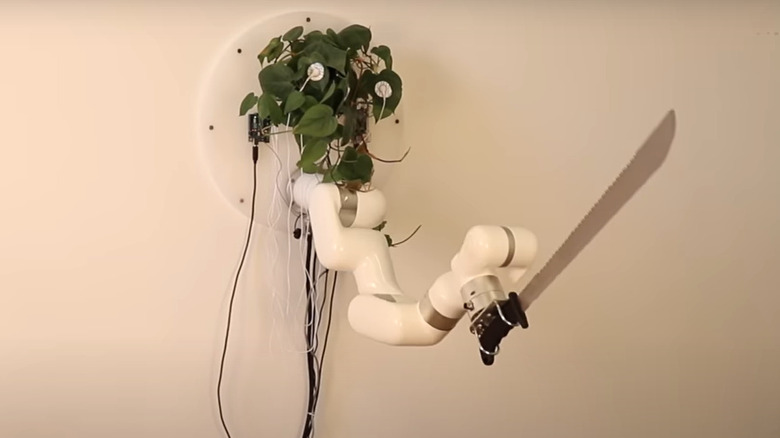This Living Plant Has The Ability To Control A Machete
Just in case war in the Middle East, war in Ukraine, global warming, fractious right/left sociopolitical divides, and the inescapable crush of inflation weren't enough, now we've got one more thing to worry about: "The Rise of the Machete Plants" (movie title pending). Yes, while some of the world's brightest minds put their efforts toward unraveling the secrets of the cosmos, delving into safe applications of artificial intelligence, and developing a more just and lawful society for all, other people ask: What if my fern could kill me?
Okay, when we say "people" we mean one guy: artist David Bowen. And when we say "fern" we mean philodendron (seen above). Details, details. Back in and August and September, 2022 (on Vimeo and YouTube), respectively, Brown posted a video of a wall-mounted, machete-wielding philodendron. The plant can be seen taking swings at the air with an honest-to-goodness machete gripped by a swiveling robot arm — and perhaps wondering why the human hasn't wandered close enough yet. How was this accomplished? With electrodes like those used in an EKG. As Vimeo reads, "The system uses an open source micro-controller connected to the plant to read varying resistance signals across the plant's leaves. Using custom software, these signals are mapped in real-time to the movements of the joints of the industrial robot holding a machete." Well, there you have it.
And what's the purpose of equipping plant life with the means of murder? As the David Bowen website shows, it's all in the name of art.
Now even the plants can kill us
Taking a stroll through David Bowen's website, it's clear that this whole plant machete thing is just one art project out of many going back decades. Other highlights include a "phototropic drawing device" featuring a robot that follows light sources to draw figures using charcoal, a "cloud piano" that plays compositions based on cloud patterns, and "fly tweet," which writes tweets based on the movements of flies — so basically, a step above the cogency of a typical tweet. In other words, there's no reason to think that the whole plant machete thing is the singular passion project of a mad tinkerer and Bond villain intent on amputating hairless primates everywhere. Maybe.
Looking to how plant machete actually works, there's a "control system" that "reads and utilizes the electrical noises" produced by a plant, the David Bowen website says. As ScienceDirect recounts, researchers have studied the electrical signals produced by plants for quite some time now. Questions still remain, however, like whether or not the signals have decipherable patterns. But before you jump to conclusions: No, when the machete-wielding philodendron in Bowen's video swings its machete around, it's not figuring out how to use its new favorite toy. The movements of the machete are simply a byproduct of the natural, internal salvo of electrical signals generated by the plant, same as those present in any other living creature. But still, don't get too close.
The technical fine print
Looking to the details of how plant machete works, Vice point to a Raspberry Pi circuit board, an Arduino microcontroller, the aforementioned electrodes to transmit electrical impulses, and a power source that plugs into the wall. Oh, and a philodendron, a household plant common enough to be sold at Ikea. Upon hearing this, the electronically-versed may blurt, "That's it? I could have done that!" Yes, but you didn't. Or at least, you didn't record it like David Bowen and put it online. For everyone else: We'll explain.
Raspberry Pi is a brand of circuit board suitable not only for DIY computer nerds but also for kids and their school projects. They've got ethernet ports, USB ports, processors, RAM: Everything that lives in your desktop or laptop. An Arduino microcontroller is a relay unit that transmits and regulates electric signals — the company even has a blog post showing how a relay and a Raspberry Pi can be networked into an access control unit (ACU) for a door locked by a card reader. While we can't see exactly how Bowen set up his project, his circuit would start with the plant, go through the electrodes and into the relay, and pass to the circuit board that controls the robot arm. Boom.
Now the question begs: Would it be plant-on-plant murder if we mounted a machete plant on a wheeled robot and sent it hacking through a jungle on a foray to discover lost cities of unplundered riches? It's something worth considering.

